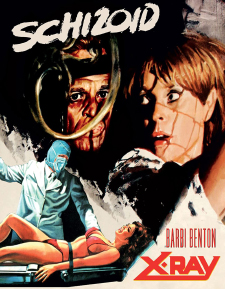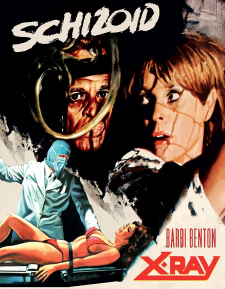Schizoid/X-Ray (4K UHD Review)

Director
David Paulsen/Boaz DavidsonRelease Date(s)
1980/1982 (April 26, 2022)Studio(s)
Cannon Film Distributors (Vinegar Syndrome)- Film/Program Grade: See Below
- Video Grade: See Below
- Audio Grade: See Below
- Extras Grade: B
- Overall Grade: B+
Review
Schizoid and X-Ray are two films that would seem to have little in common aside from being Eighties slasher films, but they do share two very important names in common: Menahem Golan and Yoram Globus, of Cannon Films. A few years before they would settle into a comfortable groove with schlocky action films, they tried their hand cashing in on the horror craze that exploded after the runaway success of Friday the 13th. Neither Schizoid nor X-Ray are as well-remembered today as some other films from that cycle, but they’re still interesting enough examples of the genre.
Schizoid stars Marianna Hill as Julie, a newspaper advice columnist who is part of a therapy group led by Dr. Pieter Fales (Klaus Kinski). Fales has issues of his own, not least of which is his rather uncomfortable relationship with his own daughter (Donna Wilkes). Julie has been receiving threatening letters from an anonymous writer, and when members of her therapy group start falling victim to a scissors-wielding killer, she finds herself in the middle of the investigation led by two police detectives (Richard Herd and Joe Regalbuto). Schizoid also stars Craig Wasson and Christopher Lloyd.
Schizoid was written directed by David Paulsen, who had very little time to write the script, and very little money with which to shoot the film—the budget was approximately $350,000. Without having enough time to construct an elaborate plot, he took a simple approach for concealing the identity of the killer until the very end: by having nearly every single character in the film be completely off their rockers. Instead of narrative red herrings, he filled the script with characters who are red herrings. Any one of them is loony enough to be a killer. Having manic actors at his disposal like Kinski, Lloyd, and Wasson certainly didn’t hurt, but even Wilkes gives a frenzied performance in the film. To paraphrase Milan Kundera, in the kingdom of crazy, it’s hard to pick out the real monster. Schizoid doesn’t necessarily stand out in the crowded slasher field, but the constant guessing game is actually pretty fun.
Cinematographer Norman Leigh shot Schizoid on 35 mm film using spherical lenses, framed at 1.85:1 for its theatrical release. For this Ultra HD version, Vinegar Syndrome has commissioned a new 4K scan of the original camera negative. The resulting image has been digitally restored and graded for high dynamic range (only HDR10 is included on the disc). The optically printed opening title sequence is naturally a bit soft, but once that’s finished, the rest of the film looks as sharp and detailed as it can, within the limitations of the stocks that were used. A touch of speckling remains visible here and there, as well as a few very light scratches (mostly during the titles). There’s a moderate amount of grain throughout, with no sign of compression artifacting to mar it. The HDR grade is fairly restrained, primarily enhancing the contrast, with deep blacks and perhaps a touch of crush in a few of the darkest scenes. The flesh tones can be a little inconsistent, veering a bit reddish at times and overly bronzed at others, but it’s not really a distracting issue (and may even reflect the original color timing). All in all, this is an impressive upgrade over the previous home video versions.
Audio is offered in English 2.0 mono DTS-HD Master Audio, with optional English subtitles. It’s a generally clear track, but there’s just a bit of excessive sibilance in the dialogue, and a slightly harsh edge overall. Sound effects like ringing telephones and flash bulbs going off can sound particularly harsh. The score was by Craig Huxley (credited as Craig Hundley), and fans of Star Trek: The Motion Picture will recognize his distinctive invention, the “Blaster Beam,” in use here as well.
SCHIZOID (FILM/VIDEO/AUDIO) C/A-/B
X-Ray (aka Hospital Massacre) stars Barbi Benton as Susan, a woman dealing with her recent divorce and her obnoxious ex-husband. When she needs to pick up the results of a routine physical, she ends up on the eighth floor of the L.A. County Hospital, where something is clearly amiss. The patients are disturbing, the doctors are disappearing, and someone has tampered with the results of her physical, trapping her in the madness. Yet the insanity might not be as random as it seems, since it may be related to something that happened to her years earlier. X-Ray also stars Charles Lucia, Jon Van Ness, and John Warner Williams. (Watch for a cameo by Bloody Birthday child actors Elizabeth Hoy and Billy Jacoby.)
X-Ray was directed by Lemon Popsicle and The Last American Virgin director Boaz Davidson, working from a script by Marc Behm, that was based on story ideas from Davidson. While Schizoid may have turned most of the characters into red herrings, X-Ray turns pretty much everything into a potential source of menace. It’s more about creating a mood than it is about concealing the identity of the killer. Davidson upped the nuttiness quotient over most slashers of the period, making the L.A. County Hospital look like something out of Silent Hill. Everyone acts creepy, doctors and patients alike, and the film presents an almost non-stop series of “cat scares” between the real threats. In fact, Davidson pushes the atmosphere so far that it verges on surrealism, and as a result, X-Ray borders on being an absurdist comedy at times.
Barbi Benton—well, she’s still Barbi Benton, but she does throw herself into the proceedings gamely. (Benton also being Benton, Davidson of course got her naked for an examination scene, one that’s far more uncomfortable to watch than all of the gore in the film put together.) The rest of the cast tends to be as disposable as their characters, though they all do their best to act sinister, with even Davidson himself having an Alfred Hitchcock walk-on as a doctor with a malevolent glare. X-Ray is an odd film by any stretch of the imagination, but it’s a memorably atmospheric one, and it’s frequently amusing (intentionally or not).
Cinematographer Nicholas Josef von Sternberg (son of the famed director) shot X-Ray on 35 mm film using spherical lenses, framed at 1.85:1 for its theatrical release. Like Schizoid, this Ultra HD version uses a new 4K scan of the original camera negative, which has been digitally remasterd and graded for high dynamic range (only HDR10 is included on the disc). The sharpness and detail levels are similar to Schizoid, though there’s a bit more damage visible in this case—there’s still light speckling, but the scratches are more noticeable, with one very prominent during a shot at 41:18. On the other hand, the flesh tones a bit more consistent—the HDR grade still pushes the saturation levels, but not in a way that veers too reddish. The black levels are very deep, especially in the final sequence on the rooftop, and once again the heavier grain is managed perfectly by the encode. It’s another noteworthy upgrade over previous home video versions.
Audio is offered in English 2.0 mono DTS-HD Master Audio, with optional English subtitles. While the dialogue is still a bit excessively sibilant, this track is smoother overall than the one for Schizoid. The score from Arlon Ober sounds pretty good here.
X-RAY (FILM/VIDEO/AUDIO) C+/A-/B+
Vinegar Syndrome’s release of Schizoid and X-Ray is a 3-disc set that includes two UHDs and a Blu-ray. Each film is included on its own separate UHD, with no extras, in order to maximize the bit rate. The Blu-ray includes both films, as well as all of the extras. There’s also an embossed slipcover available directly from Vinegar Syndrome, limited to the first 5,000 units, which was designed by Earl Kessler, Jr. The extras are mostly new to this edition, with one archival interview included (everything is in HD):
- Shooting by March (6:43)
- Hide the Scissors (5:21)
- Blood in the Jacuzzi (7:02)
- A Wellesley Graduate (5:58)
- Ultra Violet Vengeance: The Talent & Technicians of X-Ray (26:47)
- Bad Medicine (13:01)
- Schizoid Theatrical Trailer (1:39)
Shooting By March is an interview with David Paulsen, who talks about shooting the film on a quick turnaround and a tight budget; working with Menahem Golan; and meeting Klaus Kinski, who Paulsen describes as a “real character.” Despite the lack of time and money, he describes the production as being a happy one. Hide the Scissors is an interview with Donna Wilkes, who shares about auditioning for the film; working with Kinski and Christopher Lloyd; and accidentally stabbing an actor for real during shooting. She says that she had no idea her films like this one and Angel were cult movies until she started signing autographs at conventions. (Note that this is a different interview than the one contained on the 2013 Shout! Factory Blu-ray, which isn’t included here.) Blood in the Jacuzzi is an interview with makeup artist Erica Ueland, who explains how she became involved with the film, and her own experiences making it. She thinks of the film as a time capsule of the Seventies and Eighties. A Wellesley Graduate is an interview with actress Flo Lawrence, who played Pat in the film, credited as Flo Gerrish. She says that Schizoid was originally titled Murder by Mail, and she also tells the story about how she researched stripping to play the part.
Ultra Violet Vengeance is a full making-of documentary about X-Ray, featuring interviews with actors John Van Ness and Jimmy Stathis, as well as crew members Nicholas Josef von Sternberg, Carin Berger, Alan Caso, Allan Apone, and David Boyd. They discuss shooting the film at nights in the semi-abandoned Queen of Angels Hospital; the makeup effects; how the film ended up gorier than it had been written in the script; and the overall visual look. Everyone has plenty of praise for Von Sternberg’s gifts as a cinematographer, and they also have fond memories of working with Barbi Benton. Bad Medicine is an archival interview with Boaz Davidson that was originally included on the 2013 Shout! Factory Blu-ray release of X-Ray. He gives the backstory of how he became involved with Menahem Golan and Yoram Globus, and explains how he was brought in at the last minute to replace the original director. Davidson had never worked in horror previously, but he had a good experience making the film, and he also has praise for Benton—though he tells an uncomfortable story about how the set was open for her nude scene, and even the caterers came by to watch the shoot (he seems to think that was pretty funny). Davidson says that the humor in the film was unintentional, though he admits that his background may have made it inevitable.
Schizoid and X-Ray aren’t films that anyone would have expected to be released on Ultra HD, but thanks to the fine folks at Vinegar Syndrome, here they are—together at last—in all of their 4K glory. This is a nice reminder that one should never dismiss such films as being unworthy of deluxe treatment. Schizoid and X-Ray have probably never looked this good, not even during their original theatrical releases (it’s hard to imagine Cannon spending more than the bare minimum for prints). These presentations put even the previous Blu-ray editions to shame. Fans of the films should be thrilled, but the set is still worth a look for those who may be on the fence about them.
- Stephen Bjork
(You can follow Stephen on social media at these links: Twitter and Facebook.)

